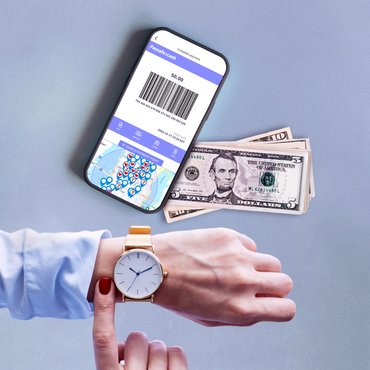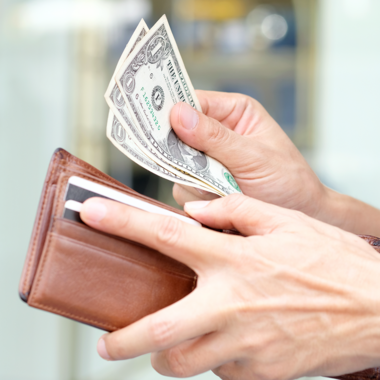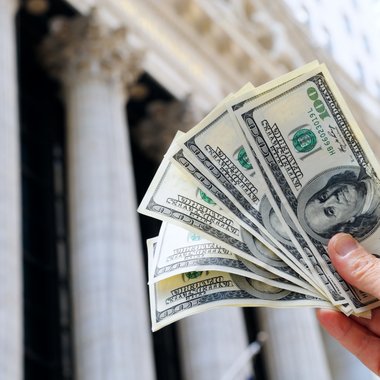How eCash payments can help U.S. borrowers make loan repayments on time
Jun 21, 2022Student loans. Car loans. Housing loans... Fresh out of a global pandemic and with inflation at historic levels, it's increasingly difficult for the average American to keep up with their ever-expanding list of financial obligations.

A typical household is around $155,622 in debt.
Meanwhile, incomes have shrunk by 3%, while the cost of living has risen by more than 8%.
But if the state of the economy is making it harder for most to keep up with their various debts, it has put the 63 million Americans who are unbanked or underbanked in an almost impossible situation.
As digital payments continue to proliferate, the gap between those who can pay off their debts with relative ease and convenience, and those who can't will only widen further increasing the payment dilemma. Which is why the need for repaying loans and other debts with eCash has never been stronger.
The debt trap
Despite working full-time hours, many Americans on low wages don't earn enough to comfortably make ends meet. As a result, they regularly have to turn to credit, either as a stop-gap between paychecks, or as a longer-term solution to plugging the shortfall in their income.
The problem is that, when you're unbanked or underbanked, credit is much more expensive and harder to obtain.
According to the Federal Deposit Insurance Corporation's latest survey, only 8% of the underbanked have access to credit-building products that would enable them to borrow at reasonable rates. As a result, many turn to payday loans with three-figure interest rates and steep fees that kick-start an endless debt spiral.
Even when it's possible to obtain a traditional loan, making repayments is a fraught experience.
To begin with, juggling repayments requires a delicate balancing act. As RentMoola's chief product officer Jean-François Brissot observed during a podcast discussion on financial inclusion:
"When you're living paycheck to paycheck, one day matters... You can't afford to send money in advance to make sure it arrives on time... You have to make the payment at the last minute, when you receive your salary or cash your check."
More to the point, 78% of the unbanked and underbanked work low-income jobs that are paid at least partly in cash. But the shift to digital in the wake of the COVID-19 pandemic means paying in cash has become harder and more time-consuming, and even risky.
Leveling the playing field
During the 2010s, the federal government launched several initiatives aimed at tackling financial exclusion.
But while making it easier to open bank accounts certainly helps, it's only part of the solution. For the traditional banking system to be truly accessible to everyone, it also needs to be affordable for those on low incomes as well as meet their practical realities.
Case in point, the minimum balance required for maintenance fees to be waived — as well as ATM fees, overdraft fees, and other charges — put bank accounts out of reach for many. 50% of the unbanked say the reason they don't have a bank account is that they can't afford one.
But even where access or affordability aren’t an issue, depositing cash-based paychecks may not be practical. In the words of SVP, Enterprise Sales, North America Jan Marc Kuelper:
"...people need to go to a single payment location across town and get in line with other people, which means time away from work.”
And that’s before you factor in other issues, such as the distance from a branch or lack of access to identification documents.
Clearly, for bank accounts to be truly accessible, depositing cash should be quick and easy. And that’s where eCash comes in.
Simplicity, access, convenience: how eCash benefits both lenders and borrowers
"Cash is the last means of payment in many, many cases... it's not only about the underbanked. In the U.S., 31% of all transactions are still in cash... [and] not everyone is able to pay digitally…”
eCash was designed with simplicity and accessibility in mind.
To begin with, it turns convenience stores and other retail locations people use every day into places where they can walk in and deposit cash into their bank accounts quickly and easily.
But eCash makes paying loans much simpler too. Lenders can embed a barcode in their loan statements. Or customers can log on to the lender's online portal, choose to pay in cash, and get a barcode they can download or print off.
Once the barcode is in hand, the customer can walk into one of more than 70,000 payment points across the U.S., show the barcode, and pay in cash.
It's a straightforward process that doesn't require specialized knowledge or access to a bank account.
Crucially, the merchant is immediately notified when the transaction is made, which means those on low incomes can stretch their paychecks as much as possible without the risk of their accounts being put in default. And because it's cash, the payment is guaranteed by definition, which lowers transaction costs for lenders and eliminates the risk of chargebacks.
A truly inclusive financial system gives people what they need, not what it thinks they need
"There's a payment dilemma in the U.S.," says Jan Marc Kuelper.
"On the one hand, we have great innovations... new technologies that simplify payments. On the other hand, there are the underbanked, whose biggest problem isn't how to make a payment as convenient as possible, but how to actually pay their bills."
In order to truly serve these customers, giving them bank accounts and innovative digital products will only go so far. For the financial system to be inclusive, it must address customers’ real needs and solve their problems. And that means making it easy for them to make cash deposits and pay for anything — including loans — in cash. Both online and offline.
As Paysafe's director of business development, eCash U.S. Victor Lolas observes in the discussion with Greg Myers from Leaders in Payments Podcast:
"There's a difference between becoming a fully banked society and a cashless society... Cash will continue to play a big role… But the more digital tools we put at consumers' disposal, the easier we can make it for cash payers to participate in the digital economy."



